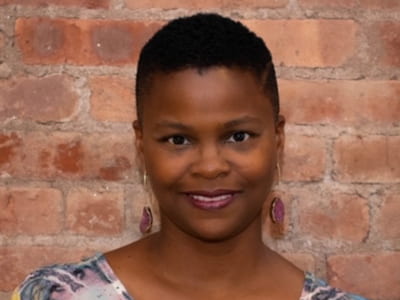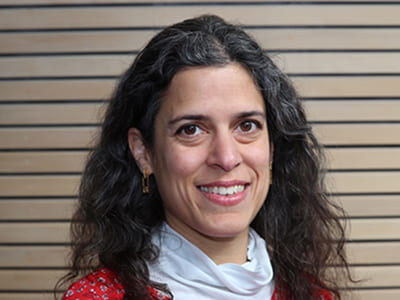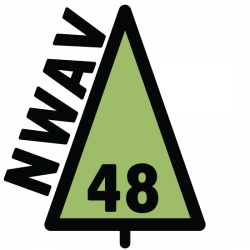We are excited to feature plenary talks by three prominent language variation and change scholars. Click on the photos or titles, or scroll down, for plenary abstracts.
 |
Alexandra D’Arcy, University of Victoria Language history, language synchrony, and kids these days Thursday night |
 |
Renée Blake, New York University ‘When black people laugh they scatter’: Embodied communication and social perception Friday night |
 |
Devyani Sharma, Queen Mary University of London Style in real time: Activation, control, and change Saturday night |
Plenary abstracts
Thursday night

Alexandra D’Arcy, University of Victoria
Language history, language synchrony, and kids these days
Synchronic language is simultaneously a reflection of history and a window to future directions of change. In this talk I explore the relation between diachrony, synchrony, and futurity. Language change unfolds constantly, instantiated “over a series of synchronic states which constitute a succession of present moments” (Joseph & Janda 2003:86), and Labov (1975, 1989, 1994) has consistently argued against the Saussurian separation of diachronic and synchronic linguistics. In enabling scrutiny in short-term increments, apparent time arguably ranks among the most important methodological advances of twentieth-century linguistics (cf. Chambers 2003:164; see also Cukor-Avila and Bailey 2013:240). However, it is a powerful lens, not a wholesale replacement for the careful study of linguistic structure and usage beyond a single synchronic time slice. Current states of language do not emerge context free. They represent ongoing and continuous change and development, leaving both footprints from earlier stages across synchronic practice as well as indicators of possible future states. The result is variation that is constrained by diachronic factors and entails the distribution of older and newer layers across contextual factors in ways that reflect their route into the language. At the same time, the grammatical system is regularly being renewed and reorganized as children participate in ongoing advancement of linguistic change. Following Romaine (1982), I take the position that the development of a viable theory of language change is critically dependent on the ability to link past and present, including active directions of change. Drawing on a series of case studies, I aim to showcase the analytical, empirical, and theoretical gains that are possible when the diachronic and the synchronic are harnessed and subsequently coupled with evidence from child language modelling and incrementation.
Chambers, J.K. 2003. Sociolinguistic Theory, 2nd ed. Malden: Wiley-Blackwell.Cukor-Avila, P. & G. Bailey. 2013. Real time and apparent time. In J.K. Chambers & N. Schilling (eds.), The Handbook of Language Variation and Change, 2nd ed. Boston: Wiley-Blackwell. 239-262.Joseph, B.D. & R.D. Janda. 2003. On language, change, and language change—or, of history, linguistics, and historical linguistics. In B.D. Joseph & R.D. Janda (eds.), The Handbook of Historical Linguistics. Oxford: Blackwell. 3-180.
Labov, W. 1975. On the use of the present to explain the past. In L. Heilmann (ed.), Proceedings of the 11th International Congress of Linguists. Bologna: Il Mulino. 825-851.
Labov, W. 1989. The child as linguistic historian. Language Variation and Change 1:85-94.
Labov, W. 1994. Principles of Linguistic Change, vol.1, Internal Factors. Cambridge: Blackwell.
Romaine, S. 1982. Socio-historical Linguistics: Its Status and Methodology. Cambridge: Cambridge University Press.
Friday night

Renée Blake, New York University
‘When black people laugh they scatter’: Embodied communication and social perception
John R. Rickford and Angela E. Rickford’s (1976) work on “Cut-Eye and Suck-Teeth: African Words and Gestures in New World Guise,” describe a visual and oral gesture, respectively, as cultural talk within Black Diasporic communities across West Africa, the Caribbean and the United States. More than 30 years have passed since this important paralinguistic work that highlighted the body in Black communication. In this talk, I expand on this work in embodied sociolinguistics and present analyses of black gestural embodiment in United States contexts. I focus on gestures as “central to the production, perception, and social interpretation of language.” (Bucholtz and Hall 2016). I argue that studying the body in Black expression, while focused on agentive beings engaged in face-to-face interactions, must be framed within histories in which Black bodies are subjected to historical systems of oppression (hooks 2013).
Three decades after Rickford and Rickford’s seminal work, there have been few sociolinguistic studies on African American expression regarding embodied styling of speech and related indexical meanings (Barrett 1999, Goodwin and Alim 2010). This is in contrast to the study of spoken African American Language, particularly regarding linguistic variation and change, which has blossomed into an intellectual forest of sorts across social categories including sex, gender, age and their intersections, as well as style, contact, religion and education. As Bucholtz and Hall (2016) note, the logocentric nature of linguistic inquiry has led to work on the spoken word overshadowing work on the body, which is generally viewed in linguistics as secondary in communication. One exception to this has been studies of Black ASL, in which “the body supplies the grammar for the entire linguistic system.” (McCaskill, et al. 2011). Moreover, while prosody/intonation is arguably integral to the information structure of spoken language, when viewed as the integration of spoken language and the body, there has been a growing body of research on African American English prosody/intonation (Tarone 1973, Loman 1975, Wolfram and Thomas 2002, Thomas and Carter 2006, Holliday 2016, McLarty 2018).
I analyze embodied cultural and linguistic practices in Black communities via new forms of data made available through advances in commuter mediated communication. And I offer a community-based approach to the body that includes the Black ASL community. This work highlights the possibilities of conflict or oppositionality in face-to-face interactions, but also reveals critical elements of communitas. While gestures are viewed as performative acts at the intersection of styling blackness and stancetaking, I argue that they can be use by the media and in face-to-face interactions to reify social categorization (e.g., ghetto girls, thugs), as well as to challenge and break such notions and perceptions.
References
Barrett, Rusty. 1999. “Indexing Polyphonous Identity in the Speech of African American Drag Queens.” In Indexing polyphonous identity in the speech of African American drag queens, by Mary Bucholtz, A.C. Liang and Laurel A Sutton, 313-331. Oxford: Oxford University Press.
Bucholtz, Mary, and Kira Hall. 2016. “Embodied Sociolinguistics.” In Sociolinguistics: Theoretical Debates, 173-198. Cambridge: Cambridge University Press.
Goodwin, Marjorie Harness, and H. Samy Alim. 2010. “‘Whatever (Neck Roll, Eye Roll, Teeth Suck)’: The Situated Coproduction of Social Categories and Identities through Stancetaking and Transmodal Stylization.” Journal of Linguistic Anthropology 20 (1): 179-194.
Holliday, Nicole. 2016. “Intonational Variation, Linguistic Style and the Black/Biracial Experience.” Ph.D. diss., New York University.
hooks, bell. 2013. Writing beyond race : living theory and practice. New York: Routledge.
Loman, Bengt. 1975. “Prosodic Patterns in a Negro American Dialect.” In Style and Text: Studies Presented to Nils Erik Enkvist, by Håkan Ringbom, Alfhild Ingberg, Ralf Norrman, Kurt Nyholm, Rolf Westman and Kay Wikberg, 219-242. Stockholm: Språkförlaget Skriptor.
McCaskill, Carolyn, Ceil Lucas, Robert Bayley, and Joseph Christopher Hill. 2011. The Hidden Treasure of Black ASL: Its History and Structure. Washington DC: Gaullaudet University Press.
McLarty, Jason. 2018. “African American Language and European American English Intonation Variation Over Time in The American South.” American Speech 93 (1): 32-78.
Rickford, John R., and Angela E. Rickford. 1976. “Cut-Eye and Suck-Teeth: African Words and Gestures in New World Guise.” The Journal of American Folklore (American Folklore Society) 89 (353): 294-309.
Tarone, Elaine E. 1973. “Aspects of Intonation in Black English.” American Speech 29-36.
Thomas, Erik R, and Phillip M Carter. 2006. “Prosodic Rhythm and African American English.” English World-Wide 331-355.
Wolfram, Walt, and Erik R Thomas. 2002. The Development of African American English: Evidence from an Isolated Community. Oxford: Blackwell.
Saturday night

Devyani Sharma, Queen Mary University of London
Style in real time: Activation, control, and change
Theories of variation in speech style have moved from an early focus on attention to speech to more comprehensive models based on audience, identity, and indexicality, sometimes seen as having ‘very largely supplanted the attention to speech explanation’ (Coupland 2007:54). This interest in social constructivist processes has moved away from the cognitive underpinnings of Labov’s original (1972) model. In this talk I return to the cognitive reality of style shifting through an exploration of moment-to-moment fluctuations in speech style. The focus on real-time data and multilectal speakers forces us to consider cognitive factors such as style biography and acquisition, degrees of routinization, control, and attentional load, not as separate from social meaning but as a key part of it.
I examine several cases of real-time style control at the micro-interactional scale. I first show that increased attentional load can affect a vernacular speaker’s ability to consistently maintain formal variants, suggesting a basic processing cost that speakers must manage (Sharma and McCarthy 2018). I then show differences in how vernacular variants are reactivated when speakers revert to a casual style, also suggesting different degrees of inhibitory control (Green 1998) and a distinction between effortful and routinized style monitoring and production (Kahneman 2011; cf. Campbell-Kibler 2013 for perception). Such effects can subtly indicate a speaker’s more default, dominant, or practised style. Rather than being orthogonal to social meaning or identity, I suggest that these tiny signals of ease and effort in speech contribute to “assumed ‘real’ selves” (Giles et al. 1991: 11) during interaction. Thus, for example, where a simple group-oriented model of accommodation predicts that convergence builds rapport, I show that diverging towards one’s own default or dominant style can build credibility and trust (Sharma 2018).
Style production is thus infused with signals of lifetime style acquisition and use, as in bilinguals. These may correspond to non-agentive variation, but can also be central to interlocutors’ co-construction of credible selves. I suggest that game theoretic models (Goffman 1961; Dror et al. 2013; Burnett 2017) are well-placed to capture this expanded cognitive model of style, involving not only orientation to group and identity, but also trade-offs in processing costs (style dominance, linguistic constraints), multiple tactics for achieving a social goal, and real-time updates in interlocutors’ information. In closing, I discuss how micro-level dynamics may underpin patterns of long-term stability and change at the community level.
References
Burnett, Heather. 2017. Sociolinguistic interaction and identity construction: The view from game-theoretic pragmatics. Journal of Sociolinguistics 22 (1): 238-271
Campbell-Kibler, Kathryn. 2013. Connecting attitudes and language behavior via implicit sociolinguistic cognition. In Tore Kristiansen, Stefan Grondelaers (eds.) Language (De) standardisation in Late Modern Europe: Experimental Studies. Oslo: Novus, pp. 307-330
Coupland, Nikolas. 2007. Style: Language Variation and Identity. Cambridge: Cambridge University Press
Dror, Moshe, Daniel Granot, and Malcah Yaeger-Dror. 2013. Speech variation, utility, and Game Theory. Language and Linguistics Compass 7 (11): 561–579
Giles, Howard, Nikolas Coupland, and Justine Coupland. 1991. Accommodation theory: Communication, context, and consequence. In Howard Giles, Nikolas Coupland and Justine Coupland (eds.) The Contexts of Accommodation. New York: Cambridge University Press, pp. 1–68
Goffman, Erving. 1961. Encounters: Two Studies in the Sociology of Interaction. Oxford: Bobbs-Merrill
Green, David. 1998. Mental control of the bilingual lexico-semantic system. Bilingualism: Language and Cognition 1:67–81
Kahneman, Daniel. 2011. Thinking, Fast and Slow. London: Allen Lane
Labov, William. 1972. Sociolinguistic Patterns. Oxford: Blackwell
Sharma, Devyani. 2018. Style dominance: Attention, audience, and the ‘real me’. Language in Society 47 (1): 1-33
Sharma, Devyani, and Kathleen McCarthy. 2018. Attentional load and style control. In J. Kodner and L. Arnold (eds.) Penn Working Papers in Linguistics 24:2

